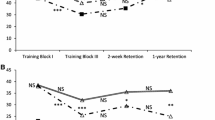Abstract
Background
“Massed” and “distributed” practice are important concepts in the acquisition of fine motor skills, and may be important in training in procedural skills.
Methods
A total of 41 novice subjects were recruited and randomized to three groups to receive training on the MIST VR surgical trainer. There were 14 subjects in each of groups A and B and 13 subjects in group C. Training comprised 20 min of massed practice for group A, 20 min of distributed practice in 5 min blocks for group B, and 15 min of distributed practice in 5-min blocks for group C. Following the training period, all groups had a 5-min rest period, followed by a 5-min retention test. Comparisons were made between groups A and B, and groups A and C.
Results
There was a statistically significant difference between groups A and B (p= 0.023) on the retention test, with group B performing better. The increment between the groups was 19% for the overall score on MIST VR. There were also significant differences in the time taken to complete the task during the training phase (p=0.023, training blocks 3 and 4). Graphical representation suggests no effect between groups A and C, and statistical analysis confirms that the observed difference in median score is not significant.
Conclusion
This study demonstrates a benefit for distributed practice over massed practice in learning laparoscopic surgical skills on the MIST VR surgical trainer. This finding has potential implications for skills training in all areas of medicine.
Similar content being viewed by others
References
Adams JA (1987) Historical review and appraisal of research on the learning, retention, and transfer of human motor skills. Psychol Bull 101: 41–74
Bohan M, Pharmer JA, Stokes AF (1999) When does imaginary practice enhance performance on a motor task? Percept Mot Skills 88: 651–658
Bourne LE, and Archer EJ (1956) Time continuously on target as a function of distribution of practice. J Exp Psychol 51: 25–33
Darzi A, Smith S, Taffinder N (1999) Assessing operative skill: needs to become more objective [Editorial]. Br Med J 318: 887–888
Deliss L, Hudson I (1998) A new surgical timetable. Ann R Coll Surg Engl 80: 17–91
Donovan JJ, Radosevich D J (1999) A meta-analytic review of the distribution of practice effect: now you see it, now you don’t. J Appl Psychol 84: 795–805
Hunter S, McLaren P (1993) Specialist medical training and the Calman report. Br Med J 306: 1281–1282
Kelty C, Duffy J, Cooper G (1999) Out-of-hours work in cardiothoracic surgery: implications of the new deal and Calman for training. Postgrad Med J 75: 351–352
Kimble G (1949) An experimental test of a two-factor theory of inhibition. J Exp Psychol 39: 15–23
Lee TD, and Genovese ED (1988) Distribution of practice in motor skill aquisition: learning and performance effects reconsidered. Res Q Exercise Sport 59: 277–287
Martin JA, Regehr G, Reznick R, MacRae H, Mumaghan J, Hutchison C, Brown M (1997) Objective structured assessment of technical skill (OSATS) for surgical residents. Br J Surg 84: 273–278
Reznick R, Regehr G, MacRae H, Marting J, McCulloch W (1997) Testing technical skill via an innovative “bench station” examination. Am J Surg 173: 226–230
Reznick RK (1993) Teaching and testing technical skills. Am J Surg 165: 358–361
Rosser JC Jr, Rosser LE, Savalgi RS (1998) Objective evaluation of a laparoscopic surgical skill program for residents and senior surgeons. Arch Surg 133: 657–661
Rosser JC, Rosser LE, Savalgi RS (1997) Skill acquisition and assessment for laparoscopic surgery. Arch Surg 132: 200–204
Smith R (1998) All changed, changed utterly: British medicine will be transformed by the Bristol case. Br Med J 316: 1917–1918
Sutton C, McCloy R, Middlebrook A, Chater P, Wilson M, Stone R (1997) MIST VR: a laparoscopic surgery procedures trainer and evaluator. Stud Health Technol Inform 39: 598–607
Taffinder N, Sutton C, Fishwick RJ, McManus IC, Darzi A (1998) Validation of virtual reality to teach and assess psychomotor skills in laparoscopic surgery: results from randomised controlled studies using the MIST VR laparoscopic simulator. Stud Health Technol Inform 50: 124–130
Whitley JD (1970) Effects of practice distribution on learning a fine motor task. Res Q 41: 576–583
Wolfe JH (1998) General surgical training—improvements and problems. Vascular Advisory Committee of the Vascular Surgical Society of Great Britain and Ireland. Ann R Coll Surg Engl 80: 112–116
Author information
Authors and Affiliations
Additional information
Online publication: 26 March 2002
Rights and permissions
About this article
Cite this article
Mackay, S., Morgan, P., Datta, V. et al. Practice distribution in procedural skills training. Surg Endosc 16, 957–961 (2002). https://doi.org/10.1007/s00464-001-9132-4
Received:
Accepted:
Issue Date:
DOI: https://doi.org/10.1007/s00464-001-9132-4




